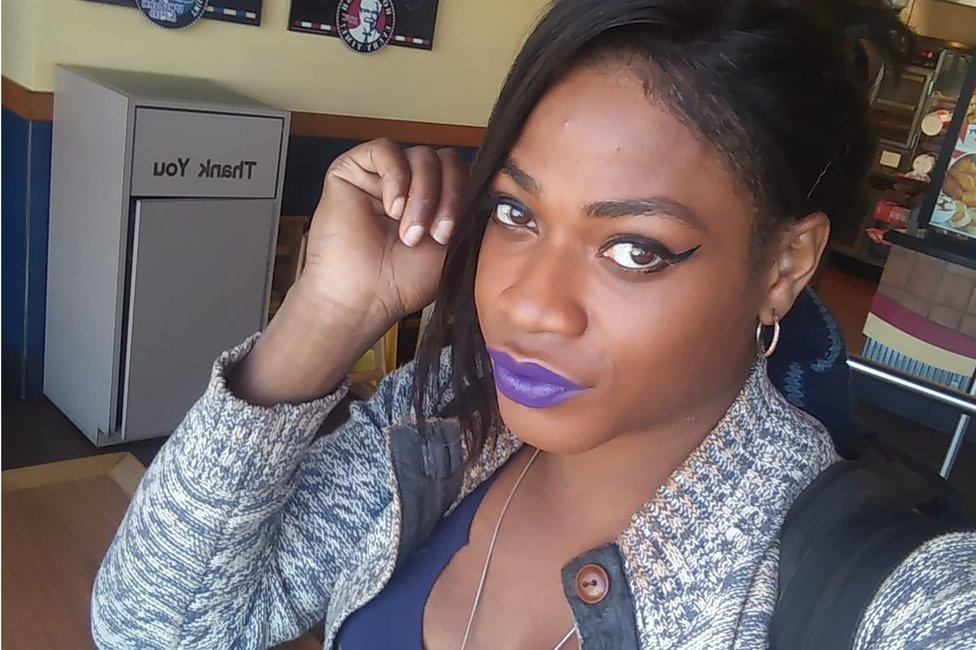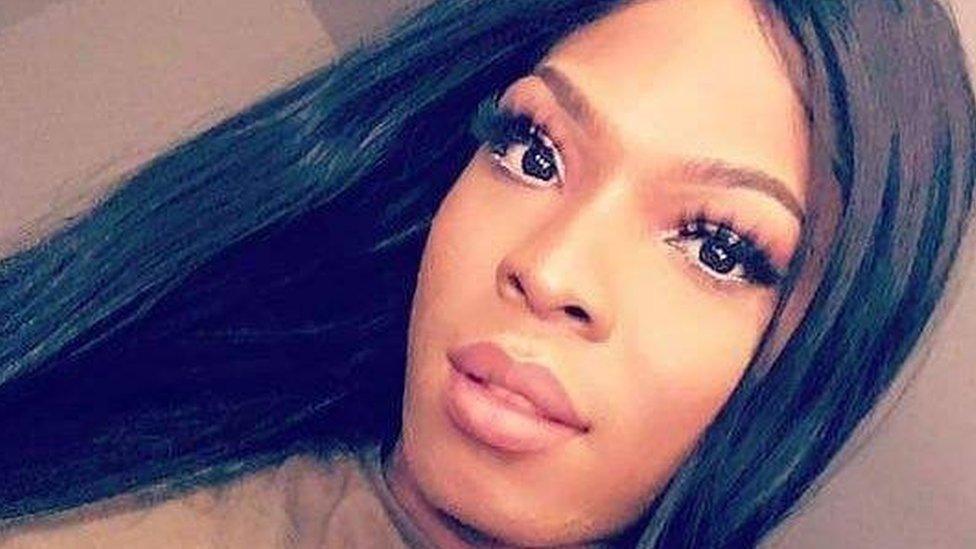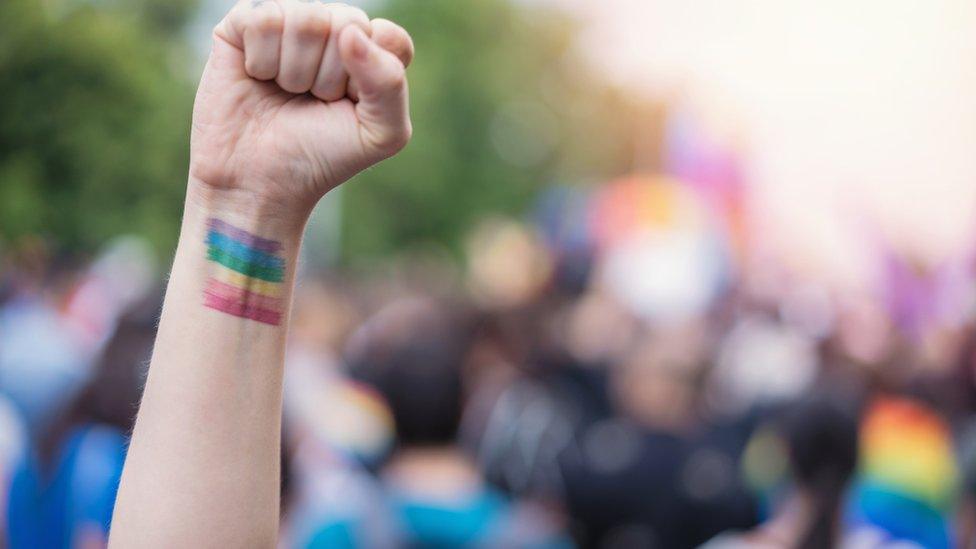Chynal Lindsey: Why are black trans women being killed in Dallas?
- Published

Chynal Lindsey's body was found in Dallas on Saturday afternoon
Last Saturday a young transgender woman's body was found in a lake in Dallas, Texas. The police identified her as 26-year-old Chynal Lindsey shortly afterwards.
It was later confirmed that Ms Lindsey had been killed - city police chief U Reneé Hall told reporters two days later that her body had exhibited "obvious signs of homicidal violence".
Such killings are not uncommon. Ms Lindsey was the second black trans woman in Dallas to be killed within the last three weeks, and the third over the past year.
Asked whether it was possible a serial killer was targeting these women, Ms Reneé Hall said that "right now, we don't have the evidence to substantiate that", but urged members of the trans community to "stay vigilant". Because of the scale of the problem, she added, the department has asked the FBI for assistance.
Whether or not a serial killer is behind the attacks, Chynal's death has highlighted an insidious truth - that trans women of colour in the US are disproportionately at risk of being killed.
The victims
On 18 May, 23-year-old trans woman Muhlaysia Booker was found dead on a street near a golf course in Dallas, having been fatally shot. Her death came a month after a group of men attacked her, filmed it, and posted the footage on social media.
In October last year the body of Brittany White, 29, was found in a parked car in the city, with fatal gunshot wounds.

Muhlaysia Booker was killed last month, just weeks after being assaulted
Two earlier deaths of trans women of colour in Dallas have yet to be solved, too - that of Shade Schuler in 2015, and of an unidentified trans woman in 2017, who was found in the same lake as Chynal.
And a non-fatal attack in April this year, in which a trans woman survived being repeatedly stabbed and left for dead, is also being investigated by Dallas police.
'An epidemic of violence'
According to Human Rights Campaign (HRC), an LGBTQI+ civil rights group, it's not just a Dallas issue - it's a problem across the US. Across the country, 82% of the transgender people killed last year were women of colour.
The Trans Murder Monitoring project says that in the decade between January 2008 and September 2018, a total of 2,982 trans people were killed worldwide.
"There is an epidemic of violence that is targeting the transgender community, particularly transgender women of colour, here in the United States," Sarah McBride, from HRC, tells the BBC.
"Transgender women of colour already face disproportionate rates of discrimination, of poverty, of homelessness - all factors that contribute to being at greater risk of violence. We know that when transphobia mixes with misogyny and racism, the consequences can oftentimes be deadly.
And this can start at a young age, she adds, when many trans people are rejected by their families or face instability at home - which has a knock-on effect into adulthood, both socially and economically.
However, as widespread as the problem is, HRC's statistics do show that more than half (55%) of the trans women reported to have been killed in the US last year lived in southern states.
This, Ms McBride says, is likely to be because "while social acceptance of LGBTQ people and equality continues to move forward across the United States, there are some regions of the country that struggle more with social acceptance than others".
"LGBTQ people throughout the south lack clear state-wide protections from discrimination - and while many of those cities have those protections, the lack of statewide protections can put transgender people at greater risk of violence," she adds.
An incomplete picture
But Ms McBride warns that the numbers that are publicly available may not tell the whole story, because of inconsistencies in how the deaths of trans women are recorded by police.
There is no federal obligation for police to record attacks as hate crimes, for example, which can obscure the nature of many of the killings.
In some states, victims are also often misgendered. For example in 2015, Dallas Police released police appeals "dead-naming" Shade Schuler - that is, using her birth name - along with images of her presenting as the gender she was assigned at birth, and referring to her as a male. Her death is still unsolved.
This is still happening too often, Ms McBride says - something that "can undermine the trust that the trans community has with local law enforcement".
Allow X content?
This article contains content provided by X. We ask for your permission before anything is loaded, as they may be using cookies and other technologies. You may want to read X’s cookie policy, external and privacy policy, external before accepting. To view this content choose ‘accept and continue’.

When the victim is a black trans woman, she adds, there are additional obstacles because of the fractured relationship between black communities and the police - the result of a number of killings of African-Americans by police officers.
And ultimately, she says, misgendering a victim can reinforce the stigma and discrimination that "are at the centre of the violence".
Nell Gaither, from the Dallas-based Trans Pride Initiative, agrees. After the killing of Muhlaysia Booker last month, she told Dallas News, external: "Look back over the history of the murders of trans persons - the majority go unsolved.
"They're not given a high priority by the police and are often written off as, 'This person was engaging in sex work or doing something illegal', especially if they're a person of colour."
But Ms McBride adds that many police departments are improving, by introducing new outreach programmes with trans communities, and taking care with how they identify victims.
But without federal anti-discrimination laws and clear guidelines on how to investigate transphobic hate crimes, she says it remains to be seen how effective these changes are.
- Published20 May 2019

- Published29 May 2019
